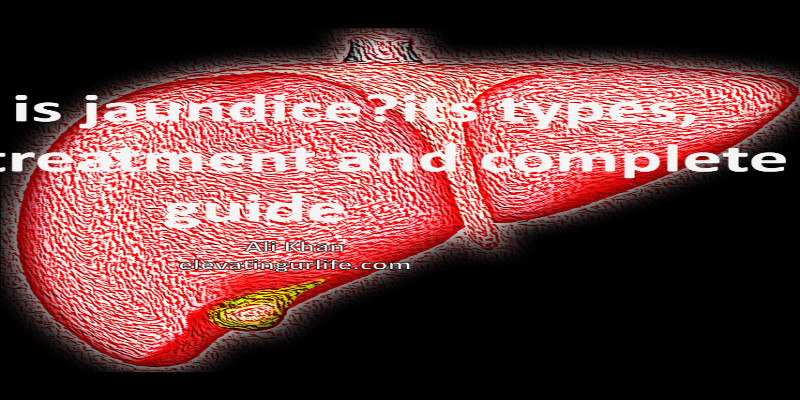- Jaundice is a pathological condition.
- Skin and sclera appear yellowish.
- Jaundice can be of 3 types.
- In majority cases, jaundice is associated with liver.
Definition
Jaundice is a pathological condition in which bilirubin accumulates in the body, giving yellowish appearance to skin, sclera(white portion of the eye) and mucous membranes.
Pathophysiology
Bilirubin is a product that is formed in the breakdown of red blood cells (also called erythrocytes).
Bilirubin arises during process of breakdown of hemoglobin molecules which is in RBCs.
Normally, liver processes bilirubin, then stored in gallbladder in bile juice.
From gallbladder bilirubin gets secreted into small intestine and this way, bilirubin excreted from the body.
In jaundice, either the production of bilirubin becomes more than normal or the process of excretion of bilirubin through normal mechanism is interrupted.
Causes
In infants, jaundice occurs when the liver of the infant is not fully mature. Therefore, the liver fails to process the bilirubin.
In adults, the causes of jaundice are divided into three categories.
Hemolytic jaundice
In hemolytic jaundice, excessive breakdown of red blood cells of the body occurs.
This in turn causes more hemoglobin degradation which is fact more bilirubin formation.
The body cannot expel much bilirubin at once, so it starts accumulating in the blood giving the surface the body a yellowish appearance.
Hemolytic anemia can cause hemolytic jaundice.
Hepatic jaundice
In hepatic jaundice, the issue lies in liver which can be either in uptake of bilirubin or its processing.
This causes accumulation of bilirubin in the body causing jaundice.
Problems with liver includes:
- Metabolic issues
- Congenital problems
- Alcohol consumption
- Chronic smoking
- Unhealthy lifestyle
- Bacterial or viral infections of liver.
Obstructive jaundice
In obstructive type, the ducts the take the bilirubin from the liver to small intestine appears to be obstructed or blocked, leading to accumulation of jaundice in the body.
The most causes includes:
- Swelling in the ducts.
- Gallbladder stones called gallstones.
- Tumor.

image source: pixabay.com
Symptoms
- Yellow skin
- Yellow sclera
- Itching in the skin
- Pale color of urine and stool
- Bloating
- metabolic issues
Tests and examination
- Ultrasound: to look for gallstones.
- MRI and CT scan: to look for liver dysfunctionalities.
- Urine test
- Cholesterol test.
Complications
One of the major complications of jaundice is kernicterus.
Kernicterus refers to brain damage and nerve palsy due to higher level of bilirubin in the body. It can affect hearing and visual response.
Treatment
Treatment depends on the underlying cause of the anomaly.
- For gallstones, we prefer surgery.
- In infants, we go for phototherapy.
- For hepatic infections, we use antiviral and antibiotics depending upon the infection where it is bacterial or viral. Liver infections are mostly viral.
Conclusion
Strictly speaking, jaundice itself is not a disease but a clinical symptom of underlying issue.
To keep liver healthy, practice improved lifestyle, eat healthy, regularly exercise and avoid alcohol and nicotine.
Read more about healthy lifestyle:
10 Amazing Mental and Physical Benefits of Exercise
8 Highly Important Healthy Food Items
Overcoming Addiction; 7 easy tips and guide
Dr. Ali Khan, a medical professional and writer, brings a unique combination of skills and expertise. With a great knowledge in the medical industry and a passion for writing, Ali Khan offers a fresh perspective on Self Help topics. Whether providing expert medical care or sharing insights through writing, Ali Khan is dedicated to making a positive impact in the lives of others. His work reflects commitment to excellence and a deep understanding of the healthcare industry and self help content writing.
Email: dralikhan5035031@gmail.com





